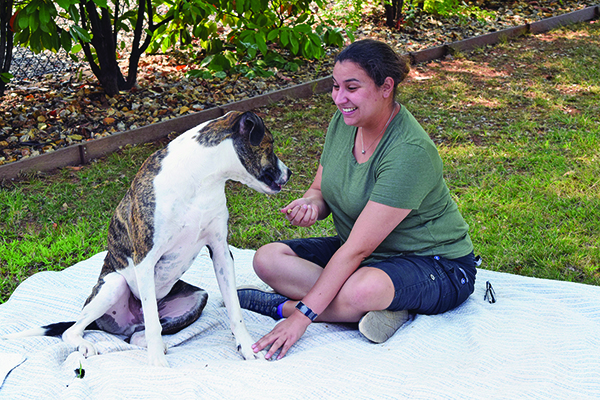
1. Determine the location of touch your dog can tolerate without reacting fearfully or aggressively. Perhaps it’s her shoulder, perhaps her elbow, or maybe just above her paw. She should be a little worried, but not growl or try to move away. This is “below threshold” – the emotional state where we want her to remain for all this work.
2. With your dog on leash, touch her briefly and gently at the spot where she is slightly below threshold – aware of your touch and somewhat concerned, but not highly concerned. The instant your dog notices your touch, start feeding her bits of chicken, non-stop. After a second or two, remove the touch and stop feeding the treats.
3. Keep repeating steps 1 and 2 until touching your dog at that location for one to two seconds consistently causes your dog to look at you with a happy smile and a “Yay! Where’s my chicken?” expression. This is a conditioned emotional response (CER); your dog’s association with the brief touch at that location is now positive instead of negative. Note: Feed the treats whether or not your dog displays the desired CER. The happy CER is a product of this process, but you don’t wait for it to happen each time.
4. Now increase the intensity of the stimulus by increasing the length of time you touch her at that same location, a few seconds at a time, obtaining the desired CER at each new touch and continue to feed for the duration of the touch. Do several repetitions of two to four seconds, until you get consistent “Yay!” looks, then several repetitions for four to eight seconds, then several four eight to 12 seconds, etc., working for that consistent CER at each new duration of your touch.
5. When you can touch your dog’s body at that spot for any length of time with her in “Yay” mode, begin to increase the intensity of stimulus again, this time by increasing the duration of your touch, then the amount of pressure, before moving your hand to a new location very slightly lower than the spot you were previously touching. I suggest starting at your initial touch location and sliding your hand to the new spot, rather than just touching the new spot. Continue with repetitions until you get consistent CERs at the new location.
6. Continue gradually working your way down to your dog’s paw, an inch or two at a time, getting solid CERs at each spot before you move closer to the paw.
7. As you work your way down the leg, be sure to add duration and pressure at each step before proceeding; each is a separate step in the CC&D procedure.
8. When you can touch, grasp, and put pressure on the paw, add lifting the paw, very slightly at first, then more and more, as you achieve the desired CER with each increase in lift. Then repeat the process with each leg. The other legs probably won’t take as long, but still, go slowly and be sure to achieve the happy CER with each step.
9. Did you think we were never going to get to the nail grinding part? We’re almost there! Start the process over again, this time with the nail grinder (or clipper) in hand. Show the tool to your dog at a sub-threshold distance until you achieve consistent CERs, then gradually move it closer (CERs at each step!) until you can touch the tool to her nail. Gradually increase the duration of the contact with her nail, and feed her a treat, again and again, until the appearance of the nail trimmer elicits a “Yay!” response. Then counter-condition the sound of the grinder (or the clipper action, by squeezing the clippers), starting again at a distance and gradually moving closer as you achieve consistent CERs at each step.
10. Go through the whole touch sequence again, this time with the trimming tool in your hand, also touching her with the tool, then again while you turn on the grinder or squeeze the clipper. Remember that you are still feeding yummy treats and obtaining the desired CER throughout the whole process. When you can hold her paw and use the tool right next to her nail with a happy response, grind or clip one nail, feed lots of treats, and stop. Do one nail a day until she’s happy with that, then advance to two nails at a time, then three, until you can grind or clip all her nails in one session.
The more complex the stimulus, the more successful the dog’s avoidance or aggressive strategies have been, and the more intense the emotional response, the more challenging it is to modify a behavior. Take your time. Be patient. A few more weeks – or months – of long nails isn’t the end of the world, and the result – a dog who willingly participates in the nail trimming procedure – is well worth the effort.
Related Articles
Grinders vs. Clippers: What’s Best for your Dog’s Nails?
What’s The Best Grinding Tool For Your Dog’s Nails?






What is a good machine to grind nails for a dog ?